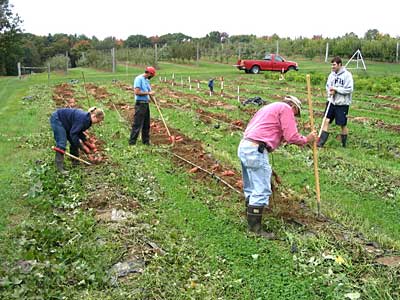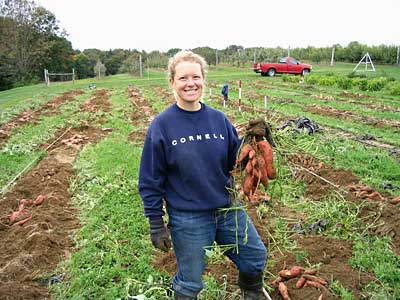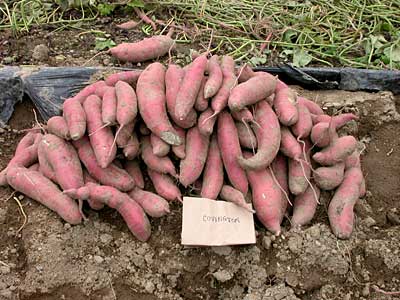In this issue:
 |
| Harvesting sweet potatoes at Becky Sideman’s research plots. |
 |
| University of New Hampshire researcher Becky Sideman with a good harvest of sweet potatoes. |
 |
| Covington sweet potatoes grown in New Hampshire. |
SWEET POTATO HARVEST AND STORAGE
Adapted by R. Hazzard from the New England Vegetable Management Guide, nevegetable.org; articles by Becky Sideman, UNH Cooperative Extension; wireworm information from J. Capinera Handbook of Vegetable Pests. Modified a bit by me.
Becky Sideman’s fact sheet on Growing Sweet Potatoes can be found at
https://extension.unh.edu/resources/files/Resource000843_Rep881.pdf
Sweet potato acreage is steadily increasing in New England as it becomes clear that this crop can yield well, store well, and has a strong market. Sweet potato harvest and storage needs differ from other common New England root crops. Once harvest is completed – generally by early to mid-October – curing and storage issues continue to be important.
Sweet potato roots continue to grow until the leaves are killed by frost or until soil temperatures fall consistently below 65°F, whichever comes first. Time of harvest is often determined by digging up a few representative plants and determining the percentage of roots in different size classes. When tops of the plants turn black after the first frost, it is imperative to harvest as quickly as possible regardless of root size.
Sweet potatoes are very susceptible to damage at harvest. Sweet potato roots do not have a thick protective outer layer of cells such as that on white potato tubers. Abrasions and wounds can lead to rots in storage.
A freshly harvested sweet potato is more starchy than it is sweet. During curing and storage, starches in the sweet potato are converted to sugars, improving flavor. It is recommended to wait at least three weeks after harvest before consuming sweet potatoes (or selling without guidance to the customer to wait) to permit the starches to convert to sugars for maximum eating quality.
Curing immediately after harvest is recommended especially when sweet potatoes will be held in storage for retail or wholesale sales. Curing minimizes damage and loss during storage by healing harvest wounds. To cure, maintain roots in temperatures between 80°F to 86°F and a high relative humidity (85-95% RH) for 4 to 7 days. This forms a corky periderm layer below the damaged areas which limits microbial invasion and water loss. A greenhouse can provide good curing conditions, as long as the greenhouse does not get too cold at night. Sweet potatoes suffer when the temperature drops below 55 F.
Sweet potatoes can maintain excellent quality for up to a year in proper storage conditions. [Actually, Becky and I have eaten sweet potatoes nearly two years old and they seem fine.] The ideal storage conditions for sweet potato are the same as for winter squash; moderately warm (55-60F) at 60-75% relative humidity. Like winter squash, sweet potato suffers chilling injury at temperatures below 55 F. Signs of chilling injury include sunken, dark areas on the tuber surface, and blackening of tubers when cut open.
Yield studies were conducted for several years by Becky Sideman at University of New Hampshire. Best yields were found in Beauregard, Covington and O’Henry (a white-fleshed variety). A good yield was 2.5 lbs per plant, equivalent to >100 lbs per 20 row-feet.
Tuber damage from wireworms can occur during the growing season and reduce marketability. More work needs to be done to understand which species is causing the damage, but likely candidates are Corn wireworm (Malanotus communis) or wheat wireworm (Agriotis mancus). Both feed on roots, stems, stolons and tubers and are pests of potato, sweet potato, other non-root vegetables crops, and grains such as wheat and oat as well as sod and grassy cover crops such as Sudangrass. Adults are most active in spring (April-June). Eggs are laid in soil and larvae feed and develop for 2, 3 or 4 years. They can survive periods without food – essentially waiting for new crops to come along. Corn wireworm adults may be especially attracted to grassy cover crops such as Sudan, thus keeping fields free of those during peak egg laying is advisable. It is difficult to trace the history and cause of wireworm damage, because it often 2-4 years after eggs are laid before the damage becomes noticeable or serious. Damage is likely to be worst when larvae are nearly full grown. There are baiting methods to sample for larvae before planting. Corn wireworm larvae are also favored by wet soil conditions thus damage may be heavier in wet areas.
Voles love sweet potatoes and can take up residence in the sweet potato field, causing significant damage. Timely harvest may reduce the level of damage. Watch storage for vole activity after harvest.
